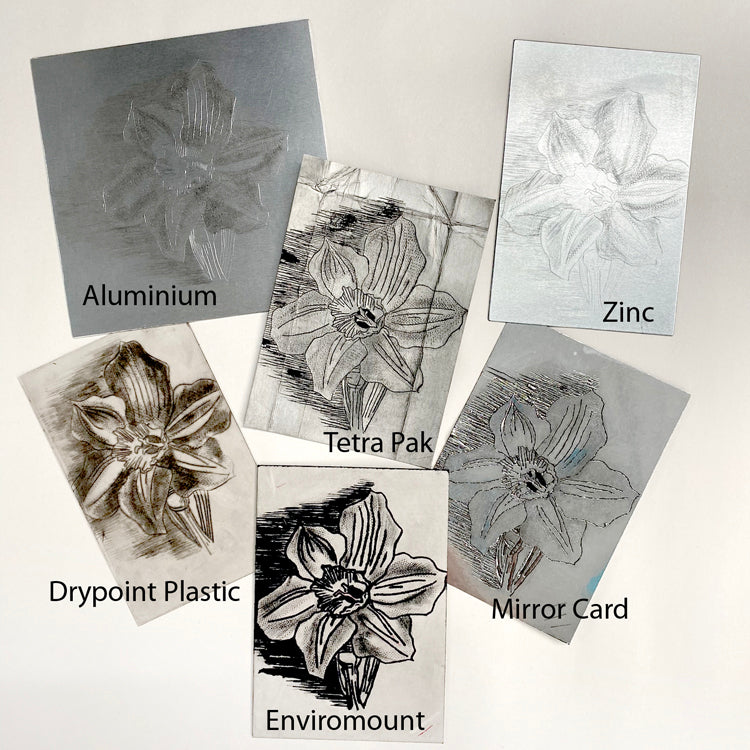Drypoint - Which plate is right for my project?


Drypoint is a fantastic intaglio technique as it requires limited equipment to create a plate. It's a great way of creating a printed drawing and is one of the printmaking techniques where the positive mark is the one that prints (unlike relief printing for example). There are lots of plates to choose from for making drypoints, and they all provide different results. We've tested six types of plate here to help you choose which is right for your project: aluminium, zinc, enviromount, drypoint plastic, mirror card and tetra pak (the inside of drinks cartons).
Aimee used one of each type of plate to create a drypoint, using the same drawing and tools each time to create comparable results.
For more instructions on creating a drypoint, watch our video here.

The first thing to test, was how to transfer a drawing to the plate. We tested carbon paper, red carbon paper, lumocolour pencil, pencil and tracing paper. The drypoint plastic is transparent, so a drypoint can be scribed straight into the plate, with a drawn image underneath. This means we don't need to plan out the image directly onto the plate (although lumocolour pencils and red carbon paper do work if you wanted to). All the plates took the red carbon paper and the lumocolour pencils, making them great options. Pencil worked on the zinc, aluminium and enviromount.
Once the drawings had been applied to the surface of the plates (using the chosen method for each plate), Aimee scribed the image using an etching needle and shaded using roulette wheels.




The plates were then ready to ink up with Akua Intaglio Ink in carbon black.




We using our etching press to take the prints, onto dampened Snowdon paper. We used the same press tension for each plate.

Aluminium - quite a soft plate. The roulette wheel created very strong marks - in retrospect a lighter touch with these would have worked better. It was easy to ink up and wipe and can handle quite a rough cleaning. This plate could easily handle a stiffer ink (like Caligo Etching Ink).
Zinc - harder than aluminium and more pressure is needed to make a mark in the surface. We added a few stronger lines with the etching needle after printing with this one the first time. It's easy to wipe, although it's possible to over-clean - less wiping provided a better print result.
Drypoint plastic - easy to scribe into. It can be tricky to see where you've drawn because of the transparency, although that does come in handy when tracing an image. This plate is easy to wipe, resulting in bright, white areas in the print if desired.
Enviromount - created a dark and smudgy print that's quite moody. The line quality is particularly nice and it's easy to get good shading from the roulette wheels. The plate is quite fragile and it wouldn't print a large edition. A stiffer ink than Akua would be harsher on the plate too, resulting in fewer prints before plate breakdown.
Mirror card - the roulette wheels created lighter marks on the mirror card but still were visible. The line quality is lovely and soft. This plate is very easy to wipe.
Tetra pak - easy to wipe but potentially easy to over-wipe and lose the image. Over-wiping can result in lines printing in white rather than black. The line quality is lovely and soft. The plate is quite fragile so this wouldn't create a large edition of prints.
